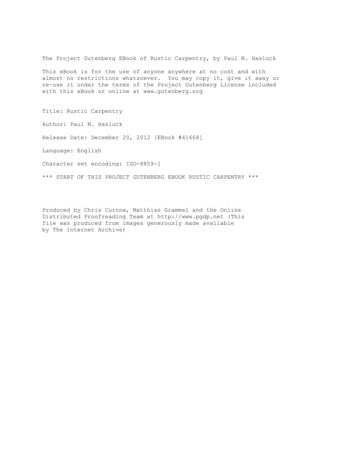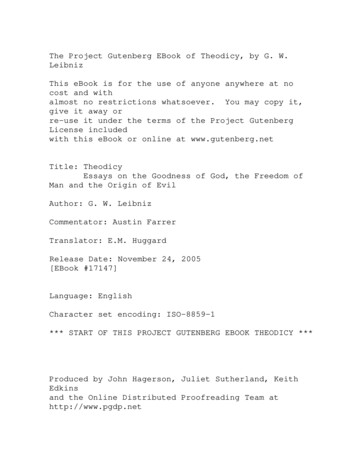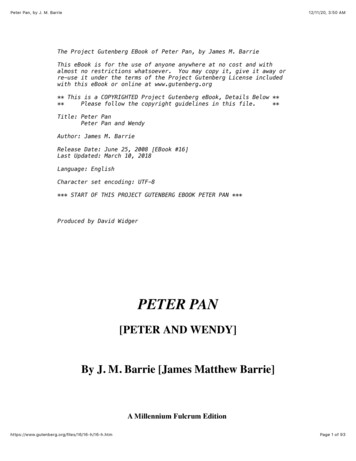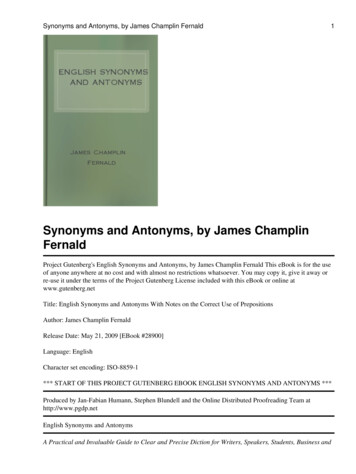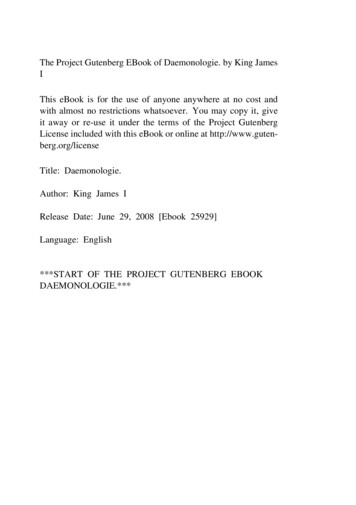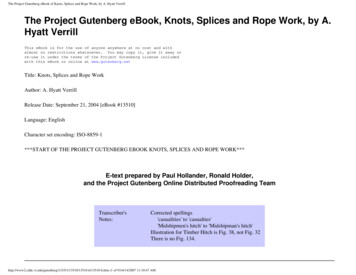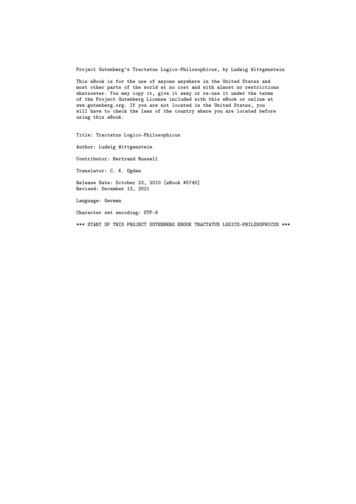
Transcription
Project Gutenberg's Tractatus Logico-Philosophicus, by Ludwig WittgensteinThis eBook is for the use of anyone anywhere in the United States andmost other parts of the world at no cost and with almost no restrictionswhatsoever. You may copy it, give it away or re-use it under the termsof the Project Gutenberg License included with this eBook or online atwww.gutenberg.org. If you are not located in the United States, youwill have to check the laws of the country where you are located beforeusing this eBook.Title: Tractatus Logico-PhilosophicusAuthor: Ludwig WittgensteinContributor: Bertrand RussellTranslator: C. K. OgdenRelease Date: October 22, 2010 [eBook #5740]Revised: December 13, 2021Language: GermanCharacter set encoding: UTF-8*** START OF THIS PROJECT GUTENBERG EBOOK TRACTATUS LOGICO-PHILOSOPHICUS ***
Produced by Jana Srna, Norbert H. Langkau, and the OnlineDistributed Proofreading Team at http://www.pgdp.netRevised by Richard TonsingTRANSCRIBER'S NOTEThe original publication was a parallel translation; after the introduction,even pages contained the German original, odd pages the English translation.This e-book has been reformatted to contain the English translation rst andthe German original after that. In the PDF le, the proposition numbers arelinked back and forth between the languages.The original used a lower-case v' for the logical or operator; it has beenreplaced with the correct ' character.In the German part of the original, variables were printed upright; theyhave been italicised in this e-book.Every e ort has been made to replicate the original text as faithfully aspossible. Minor typesetting errors have been corrected; all changes are detailedin the LATEX source code.
International Library of PsychologyPhilosophy and Scienti c MethodGeneral Editor:C. K. Ogden, m.a.Magdalene College, Cambridge )(
TractatusLogico-PhilosophicusByLUDWIG WITTGENSTEINWith an Introduction byBERTRAND RUSSELL, F.R.S.LONDONKEGAN PAUL, TRENCH, TRUBNER & CO., LTD.NEW YORK: HARCOURT, BRACE & COMPANY, INC.1922
PRINTED IN GREAT BRITAIN BY THE EDINBURGH PRESS,9 AND 11 YOUNG STREET, EDINBURGH.
NOTEIn rendering Mr Wittgenstein's Tractatus Logico-Philosophicus available for English readers, the somewhat unusual course has been adoptedof printing the original side by side with the translation. Such a methodof presentation seemed desirable both on account of the obvious di culties raised by the vocabulary and in view of the peculiar literary characterof the whole. As a result, a certain latitude has been possible in passagesto which objection might otherwise be taken as over-literal.The proofs of the translation and the version of the original whichappeared in the nal number of Ostwald's Annalen der Naturphilosophie(1921) have been very carefully revised by the author himself; and theEditor further desires to express his indebtedness to Mr F. P. Ramsey, ofTrinity College, Cambridge, for assistance both with the translation andin the preparation of the book for the press.C. K. O.
INTRODUCTIONBy BERTRAND RUSSELLMr Wittgenstein'sTractatus Logico-Philosophicus,whether ornot it prove to give the ultimate truth on the matters with which it deals,certainly deserves, by its breadth and scope and profundity, to be considered an important event in the philosophical world. Starting from theprinciples of Symbolism and the relations which are necessary betweenwords and things in any language, it applies the result of this inquiry tovarious departments of traditional philosophy, showing in each case howtraditional philosophy and traditional solutions arise out of ignorance ofthe principles of Symbolism and out of misuse of language.The logical structure of propositions and the nature of logical inference are rst dealt with.Thence we pass successively to Theory ofdasKnowledge, Principles of Physics, Ethics, and nally the Mystical (Mystische ).In order to understand Mr Wittgenstein's book, it is necessary to realize what is the problem with which he is concerned. In the part of histheory which deals with Symbolism he is concerned with the conditionswhich would have to be ful lled by a logically perfect language. There arevarious problems as regards language. First, there is the problem whatactually occurs in our minds when we use language with the intentionof meaning something by it; this problem belongs to psychology.Sec-ondly, there is the problem as to what is the relation subsisting betweenthoughts, words, or sentences, and that which they refer to or mean; thisproblem belongs to epistemology. Thirdly, there is the problem of usingsentences so as to convey truth rather than falsehood; this belongs tothe special sciences dealing with the subject-matter of the sentences inquestion.Fourthly, there is the question:what relation must one fact(such as a sentence) have to another in order to becapableof being asymbol for that other? This last is a logical question, and is the one withwhich Mr Wittgenstein is concerned. He is concerned with the conditionsforaccurateSymbolism,i.e. for Symbolism in which a sentence means something quite de nite.In practice, language is always more or lessvague, so that what we assert is never quite precise. Thus, logic has twoproblems to deal with in regard to Symbolism:(1) the conditions forsense rather than nonsense in combinations of symbols; (2) the conditions for uniqueness of meaning or reference in symbols or combinations7
INTRODUCTIONof symbols.A logically perfect language has rules of syntax which pre-vent nonsense, and has single symbols which always have a de nite andunique meaning. Mr Wittgenstein is concerned with the conditions for alogically perfect language not that any language is logically perfect, orthat we believe ourselves capable, here and now, of constructing a logically perfect language, but that the whole function of language is to havemeaning, and it only ful ls this function in proportion as it approachesto the ideal language which we postulate.The essential business of language is to assert or deny facts. Given thesyntax of a language, the meaning of a sentence is determinate as soonas the meaning of the component words is known. In order that a certainsentence should assert a certain fact there must, however the languagemay be constructed, be something in common between the structure ofthe sentence and the structure of the fact.This is perhaps the mostfundamental thesis of Mr Wittgenstein's theory.That which has to bein common between the sentence and the fact cannot, so he contends,said in language. It can, in his phraseology, only beshown, not said, for whatever we may say will still need to have the samebe itself in turnstructure.The rst requisite of an ideal language would be that there should beone name for every simple, and never the same name for two di erentsimples.A name is a simple symbol in the sense that it has no partswhich are themselves symbols.In a logically perfect language nothingthat is not simple will have a simple symbol. The symbol for the wholewill be a complex, containing the symbols for the parts.In speakingof a complex we are, as will appear later, sinning against the rulesof philosophical grammar, but this is unavoidable at the outset. Mostpropositions and questions that have been written about philosophicalmatters are not false but senseless.We cannot, therefore, answer ques-tions of this kind at all, but only state their senselessness. Most questionsand propositions of the philosophers result from the fact that we do notunderstand the logic of our language. They are of the same kind as thequestion whether the Good is more or less identical than the Beautiful (4.003).What is complex in the world is a fact.Facts which are notcompounded of other facts are what Mr Wittgenstein callsSachverhalte ,Tatsa-whereas a fact which may consist of two or more facts is called ache : thus, for example, Socrates is wise is a Sachverhalt , as well as aTatsache , whereas Socrates is wise and Plato is his pupil is a Tatsachebut not a Sachverhalt .8
INTRODUCTIONHe compares linguistic expression to projection in geometry. A geometrical gure may be pro jected in many ways: each of these ways corresponds to a di erent language, but the projective properties of the original gure remain unchanged whichever of these ways may be adopted.These projective properties correspond to that which in his theory theproposition and the fact must have in common, if the proposition is toassert the fact.In certain elementary ways this is, of course, obvious. It is impossible,for example, to make a statement about two men (assuming for the moment that the men may be treated as simples), without employing twonames, and if you are going to assert a relation between the two men itwill be necessary that the sentence in which you make the assertion shallestablish a relation between the two names. If we say Plato loves Socrates, the word loves which occurs between the word Plato and theword Socrates establishes a certain relation between these two words,and it is owing to this fact that our sentence is able to assert a relationbetween the person's name by the words Plato and Socrates. WeaRb' says a stands in a certain relation a' stands in a certain relation to b' saysmust not say, the complex sign Rtob';but we must say, thatthat aRb (3.1432).Mr Wittgenstein begins his theory of Symbolism with the statement(2.1): We make to ourselves pictures of facts. A picture, he says, isa model of the reality, and to the objects in the reality correspond theelements of the picture: the picture itself is a fact. The fact that thingshave a certain relation to each other is represented by the fact that inthe picture its elements have a certain relation to one another. In thepicture and the pictured there must be something identical in order thatthe one can be a picture of the other at all.What the picture musthave in common with reality in order to be able to represent it after itsmanner rightly or falsely is its form of representation (2.161, 2.17).We speak of a logical picture of a reality when we wish to imply onlyso much resemblance as is essential to its being a picture in any sense,that is to say, when we wish to imply no more than identity of logicalform.The logical picture of a fact, he says, is aGedanke .A picturecan correspond or not correspond with the fact and be accordingly trueor false, but in both cases it shares the logical form with the fact. Thesense in which he speaks of pictures is illustrated by his statement: Thegramophone record, the musical thought, the score, the waves of sound,all stand to one another in that pictorial internal relation which holds9
INTRODUCTIONbetween language and the world. To all of them the logical structure iscommon.(Like the two youths, their two horses and their lilies in thestory. They are all in a certain sense one) (4.014). The possibility of aproposition representing a fact rests upon the fact that in it objects arerepresented by signs. The so-called logical constants are not representedby signs, but are themselves present in the proposition as in the fact. Theproposition and the fact must exhibit the same logical manifold, andthis cannot be itself represented since it has to be in common betweenthe fact and the picture.Mr Wittgenstein maintains that everythingproperly philosophical belongs to what can only be shown, to what isin common between a fact and its logical picture.It results from thisview that nothing correct can be said in philosophy. Every philosophicalproposition is bad grammar, and the best that we can hope to achieveby philosophical discussion is to lead people to see that philosophicaldiscussion is a mistake. Philosophy is not one of the natural sciences.(The word philosophy' must mean something which stands above orbelow, but not beside the natural sciences.) The ob ject of philosophy isthe logical clari cation of thoughts.activity.Philosophy is not a theory but anA philosophical work consists essentially of elucidations.Theresult of philosophy is not a number of philosophical propositions,' butto make propositions clear.Philosophy should make clear and delimitsharply the thoughts which otherwise are, as it were, opaque and blurred (4.111 and 4.112). In accordance with this principle the things that haveto be said in leading the reader to understand Mr Wittgenstein's theoryare all of them things which that theory itself condemns as meaningless.With this proviso we will endeavour to convey the picture of the worldwhich seems to underlie his system.The world consists of facts: facts cannot strictly speaking be de ned,but we can explain what we mean by saying that facts are what makepropositions true, or false.Facts may contain parts which are facts ormay contain no such parts; for example: Socrates was a wise Athe-nian, consists of the two facts, Socrates was wise, and Socrates wasan Athenian. A fact which has no parts that are facts is called byMr Wittgenstein aSachverhalt .This is the same thing that he calls anatomic fact. An atomic fact, although it contains no parts that are facts,nevertheless does contain parts.If we may regard Socrates is wise asan atomic fact we perceive that it contains the constituents Socrates and wise. If an atomic fact is analysed as fully as possible (theoret-ical, not practical possibility is meant) the constituents nally reached10
INTRODUCTIONmay be called simples or objects. It is not contended by Wittgensteinthat we can actually isolate the simple or have empirical knowledge ofit.It is a logical necessity demanded by theory, like an electron.Hisground for maintaining that there must be simples is that every complexpresupposes a fact. It is not necessarily assumed that the complexity offacts is nite; even if every fact consisted of an in nite number of atomicfacts and if every atomic fact consisted of an in nite number of objectsthere would still be ob jects and atomic facts (4.2211). The assertion thatthere is a certain complex reduces to the assertion that its constituentsare related in a certain way, which is the assertion of afact :thus ifwe give a name to the complex the name only has meaning in virtueof the truth of a certain proposition, namely the proposition assertingthe relatedness of the constituents of the complex. Thus the naming ofcomplexes presupposes propositions, while propositions presupposes thenaming of simples.In this way the naming of simples is shown to bewhat is logically rst in logic.The world is fully described if all atomic facts are known, togetherwith the fact that these are all of them.The world is not describedby merely naming all the ob jects in it; it is necessary also to know theatomic facts of which these ob jects are constituents. Given this total ofatomic facts, every true proposition, however complex, can theoreticallybe inferred. A proposition (true or false) asserting an atomic fact is calledan atomic proposition. All atomic propositions are logically independentof each other. No atomic proposition implies any other or is inconsistentwith any other. Thus the whole business of logical inference is concernedwith propositions which are not atomic. Such propositions may be calledmolecular.Wittgenstein's theory of molecular propositions turns upon his theoryof the construction of truth-functions.A truth-function of a propositionpis a proposition containingpandsuch that its truth or falsehood depends only upon the truth or falsehoodofp,and similarly a truth-function of several propositionsone containingp, q , r. . . andp, q , r. . . issuch that its truth or falsehood dependsonly upon the truth or falsehood ofp, q , r . . .It might seem at rstsight as though there were other functions of propositions besides truthfunctions; such, for example, would be A believesp, for in general Awill believe some true propositions and some false ones: unless he is anexceptionally gifted individual, we cannot infer thatthat he believes it or thatp is true from the factp is false from the fact that he does not believe11
INTRODUCTIONit.pis a very complexis a proposition about Socrates. Mr WittgensteinOther apparent exceptions would be such as proposition or pmaintains, however, for reasons which will appear presently, that suchexceptions are only apparent, and that every function of a proposition isreally a truth-function.It follows that if we can de ne truth-functionsgenerally, we can obtain a general de nition of all propositions in termsof the original set of atomic propositions. This Wittgenstein proceeds todo.It has been shown by Dr She er (Trans. Am. Math. Soc., Vol. XIV.pp. 481 488) that all truth-functions of a given set of propositions can beconstructed out of either of the two functions not-pqor not- or not-pqand not- . Wittgenstein makes use of the latter, assuming a knowledgeof Dr She er's work.The manner in which other truth-functions areconstructed out of not-pqand not- is easy to see. Not-ppand not- ispequivalent to not- , hence we obtain a de nition of negation in termsof our primitive function:pthe negation of not-hence we can de ne qand not- , i.e.porq , of our primitive function.pdevelopment of other truth-functions out of not- and in detail at the beginning ofsince this isPrincipia Mathematica.porq Theis givenThis gives all that iswanted when the propositions which are arguments to our truth-functionare given by enumeration. Wittgenstein, however, by a very interestinganalysis succeeds in extending the process to general propositions,i.e. tocases where the propositions which are arguments to our truth-functionare not given by enumeration but are given as all those satisfying somef x be a propositional function (i.e. a functionwhose values are propositions), such as x is human then the variousvalues of f x form a set of propositions. We may extend the idea not-pand not-q so as to apply to simultaneous denial of all the propositionswhich are values of f x. In this way we arrive at the proposition whichis ordinarily represented in mathematical logic by the words f x is falsefor all values of x. The negation of this would be the proposition thereis at least one x for which f x is true which is represented by ( x) . f x. If we had started with not-f x instead of f x we should have arrived atthe proposition f x is true for all values of x which is represented by (x).f x. Wittgenstein's method of dealing with general propositions [i.e. (x) . f x and ( x) . f x ] di ers from previous methods by the fact thatcondition. For example, letthe generality comes only in specifying the set of propositions concerned,and when this has been done the building up of truth-functions proceedsexactly as it would in the case of a nite number of enumerated argumentsp, q , r . . . .12
INTRODUCTIONMr Wittgenstein's explanation of his symbolism at this point is notquite fully given in the text.The symbol he uses is(p, ξ, N (ξ)).Thefollowing is the explanation of this symbol:p stands for all atomic propositions.ξ stands for any set of propositions.N (ξ) stands for the negation of all the propositions making up ξ .The whole symbol(p, ξ, N (ξ))means whatever can be obtained bytaking any selection of atomic propositions, negating them all, then taking any selection of the set of propositions now obtained, together withany of the originals and so on inde nitely. This is, he says, the generaltruth-function and also the general form of proposition. What is meantis somewhat less complicated than it sounds. The symbol is intended todescribe a process by the help of which, given the atomic propositions,all others can be manufactured. The process depends upon:a)(She er's proof that all truth-functions can be obtained out ofsimultaneous negation,bi.e. out of not-p and not-q ;( ) Mr Wittgenstein's theory of the derivation of general propositionsfrom conjunctions and disjunctions;c( ) The assertion that a proposition can only occur in another proposition as argument to a truth-function. Given these three foundations,it follows that all propositions which are not atomic can be derived fromsuch as are, by a uniform process, and it is this process which is indicatedby Mr Wittgenstein's symbol.From this uniform method of construction we arrive at an amazingsimpli cation of the theory of inference, as well as a de nition of the sortof propositions that belong to logic. The method of generation which hasjust been described, enables Wittgenstein to say that all propositions canbe constructed in the above manner from atomic propositions, and in thisway the totality of propositions is de ned.(The apparent exceptionswhich we mentioned above are dealt with in a manner which we shallconsider later.)Wittgenstein is enabled to assert that propositions areall that follows from the totality of atomic propositions (together withthe fact that it is the totality of them); that a proposition is always atruth-function of atomic propositions; and that ifmeaning ofpis contained in the meaning ofq,pfollows fromqthefrom which of course itresults that nothing can be deduced from an atomic proposition. All the13
INTRODUCTIONpropositions of logic, he maintains, are tautologies, such, for example, as por notp. The fact that nothing can be deduced from an atomic propositionhas interesting applications, for example, to causality. There cannot, inWittgenstein's logic, be any such thing as a causal nexus.of the future, he says, cannot The eventsbe inferred from those of the present.Superstition is the belief in the causal nexus. That the sun will riseto-morrow is a hypothesis. We do not in fact know whether it will rise,since there is no compulsion according to which one thing must happenbecause another happens.Let us now take up another subject that of names. In Wittgenstein'stheoretical logical language, names are only given to simples.We donot give two names to one thing, or one name to two things.Thereis no way whatever, according to him, by which we can describe thetotality of things that can be named, in other words, the totality ofwhat there is in the world.In order to be able to do this we shouldhave to know of some property which must belong to every thing bya logical necessity.It has been sought to nd such a property in self-identity, but the conception of identity is subjected by Wittgenstein to adestructive criticism from which there seems no escape. The de nition ofidentity by means of the identity of indiscernibles is rejected, because theidentity of indiscernibles appears to be not a logically necessary principle.According to this principleproperty ofy,x is identical with yif every property ofx is abut it would, after all, be logically possible for two thingsto have exactly the same properties.If this does not in fact happenthat is an accidental characteristic of the world, not a logically necessarycharacteristic, and accidental characteristics of the world must, of course,not be admitted into the structure of logic. Mr Wittgenstein accordinglybanishes identity and adopts the convention that di erent letters are tomean di erent things. In practice, identity is needed as between a nameand a description or between two descriptions.It is needed for suchpropositions as Socrates is the philosopher who drank the hemlock, or The even prime is the next number after 1. For such uses of identity itis easy to provide on Wittgenstein's system.The rejection of identity removes one method of speaking of the totality of things, and it will be found that any other method that may besuggested is equally fallacious: so, at least, Wittgenstein contends and, Ithink, rightly. This amounts to saying that object is a pseudo-concept.To say xis an ob ject is to say nothing.14It follows from this that we
INTRODUCTIONcannot make such statements as there are more than three objects in theworld, or there are an in nite number of objects in the world. Objectscan only be mentioned in connexion with some de nite property. We cansay there are more than three ob jects which are human, or there aremore than three objects which are red, for in these statements the wordobject can be replaced by a variable in the language of logic, the variablebeing one which satis es in the rst case the function the second the function xis red. are more than three objects, xis human ; inBut when we attempt to say therethis substitution of the variable for theword object becomes impossible, and the proposition is therefore seento be meaningless.We here touch one instance of Wittgenstein's fundamental thesis,that it is impossible to say anything about the world as a whole, andthat whatever can be said has to be about bounded portions of the world.This view may have been originally suggested by notation, and if so, thatis much in its favour, for a good notation has a subtlety and suggestiveness which at times make it seem almost like a live teacher. Notationalirregularities are often the rst sign of philosophical errors, and a perfectnotation would be a substitute for thought. But although notation mayhave rst suggested to Mr Wittgenstein the limitation of logic to thingswithin the world as opposed to the world as a whole, yet the view, oncesuggested, is seen to have much else to recommend it.Whether it isultimately true I do not, for my part, profess to know. In this Introduction I am concerned to expound it, not to pronounce upon it. Accordingto this view we could only say things about the world as a whole if wecould get outside the world, if, that is to say, it ceased to be for us thewhole world.Our world may be bounded for some superior being whocan survey it from above, but for us, however nite it may be, it cannothave a boundary, since it has nothing outside it.Wittgenstein uses, asan analogy, the eld of vision. Our eld of vision does not, for us, have avisual boundary, just because there is nothing outside it, and in like manner our logical world has no logical boundary because our logic knows ofnothing outside it. These considerations lead him to a somewhat curiousdiscussion of Solipsism. Logic, he says, lls the world. The boundaries ofthe world are also its boundaries. In logic, therefore, we cannot say, thereis this and this in the world, but not that, for to say so would apparentlypresuppose that we exclude certain possibilities, and this cannot be thecase, since it would require that logic should go beyond the boundaries ofthe world as if it could contemplate these boundaries from the other side15
INTRODUCTIONalso.What we cannot think we cannot think, therefore we also cannotsay what we cannot think.This, he says, gives the key to Solipsism. What Solipsism intends isquite correct, but this cannot be said, it can only be shown.world ismyThat theworld appears in the fact that the boundaries of language(the only language I understand) indicate the boundaries of my world.The metaphysical subject does not belong to the world but is a boundaryof the world.We must take up next the question of molecular propositions whichare at rst sight not truth-functions, of the propositions that they contain, such, for example, as A believesp. Wittgenstein introduces this subject in the statement of his position,namely, that all molecular functions are truth-functions. He says (5.54): In the general propositional form, propositions occur in a propositiononly as bases of truth-operations. At rst sight, he goes on to explain,it seems as if a proposition could also occur in other ways,p. Here it seems super cially as if the propositionpe.g. A believesstood in a sort ofrelation to the ob ject A. But it is clear that A believes thatthinksp,' A saysp'are of the form psaysp';p,' Aand here we have no co-ordination of a fact and an object, but a co-ordination of facts by meansof a co-ordination of their objects (5.542).What Mr Wittgenstein says here is said so shortly that its point isnot likely to be clear to those who have not in mind the controversieswith which he is concerned.The theory with which he is disagreeingwill be found in my articles on the nature of truth and falsehood inPhilosophical Essays7.i.e.andProceedings of the Aristotelian Society,1906 The problem at issue is the problem of the logical form of belief,what is the schema representing what occurs when a man believes.Of course, the problem applies not only to belief, but also to a host ofother mental phenomena which may be called propositional attitudes:doubting, considering, desiring, etc.In all these cases it seems naturalto express the phenomenon in the form A doubtsp, A desiresp, etc.,which makes it appear as though we were dealing with a relation betweena person and a proposition.This cannot, of course, be the ultimateanalysis, since persons are ctions and so are propositions, except inthe sense in which they are facts on their own account.A proposition,considered as a fact on its own account, may be a set of words which aman says over to himself, or a complex image, or train of images passingthrough his mind, or a set of incipient bodily movements.16It may be
INTRODUCTIONany one of innumerable di erent things. The proposition as a fact on itsown account, for example the actual set of words the man pronouncesto himself, is not relevant to logic.What is relevant to logic is thatcommon element among all these facts, which enables him, as we say, tomeanthe fact which the proposition asserts.To psychology, of course,more is relevant; for a symbol does not mean what it symbolizes in virtueof a logical relation alone, but in virtue also of a psychological relation ofintention, or association, or what-not. The psychological part of meaning,however, does not concern the logician. What does concern him in thisproblem of belief is the logical schema.It is clear that, when a personbelieves a proposition, the person, considered as a metaphysical s
Oct 22, 2010 · By BERTRAND RUSSELL Mr Wittgenstein's actatusrT Lgicoo-Philosophicus , whether or not it prove to give the ultimate truth on the matters with which it deals, certainly deserves, by its breadth and scope and profundit,y to be con-sidered an impo

